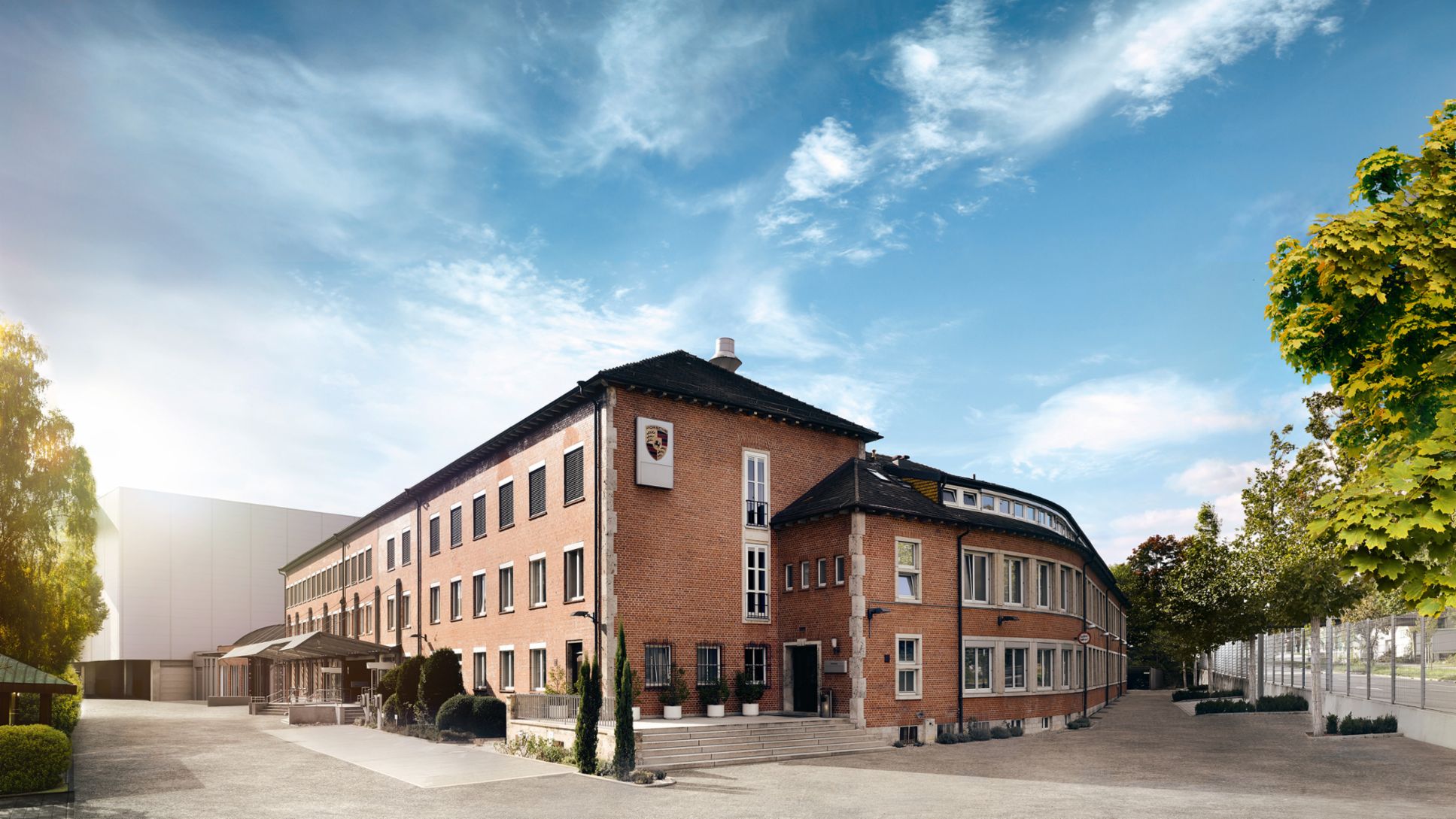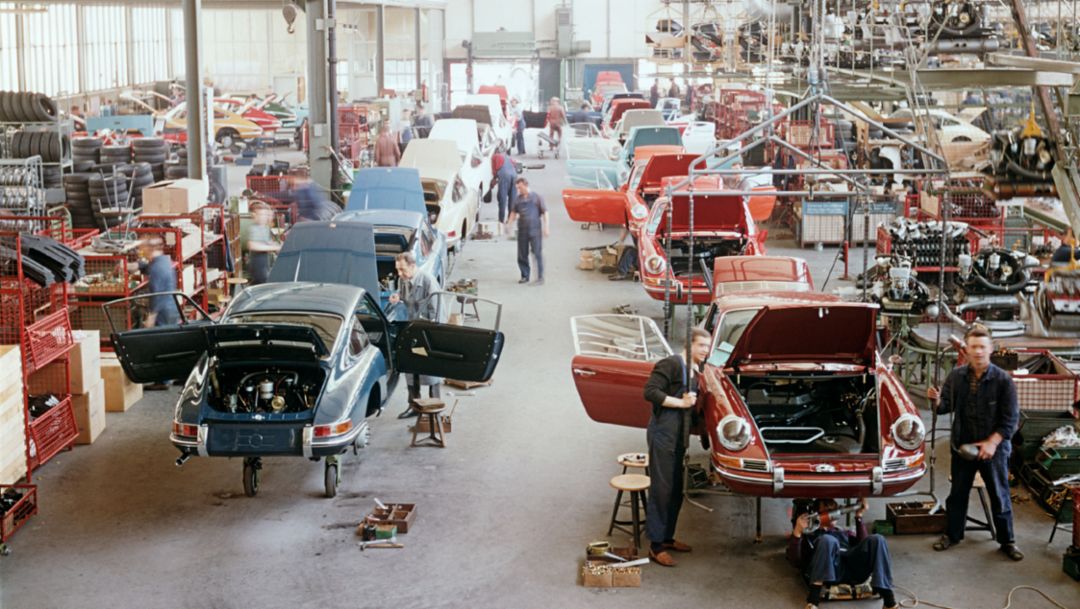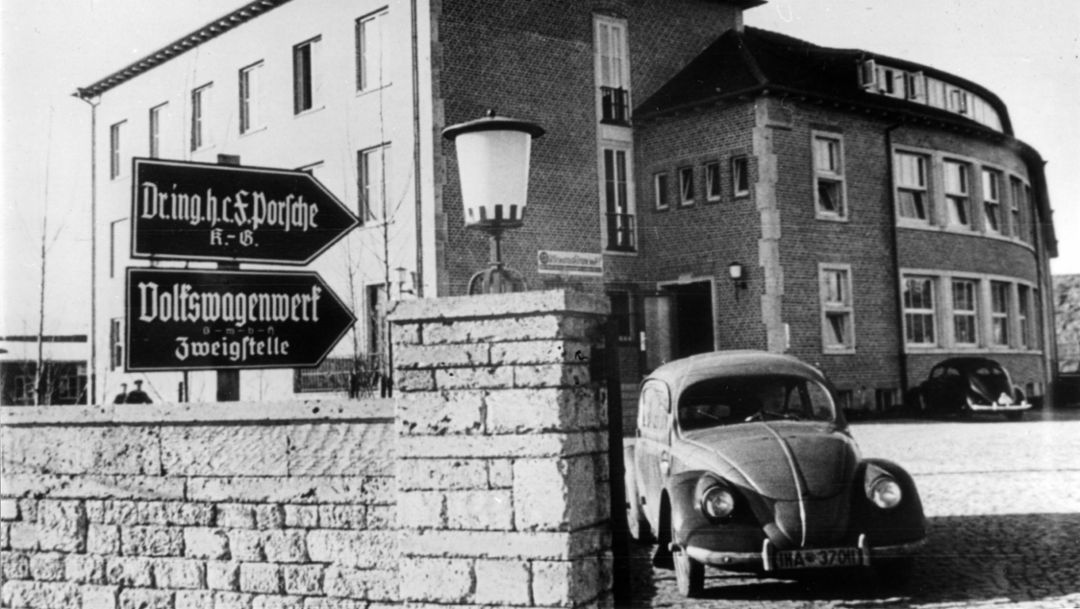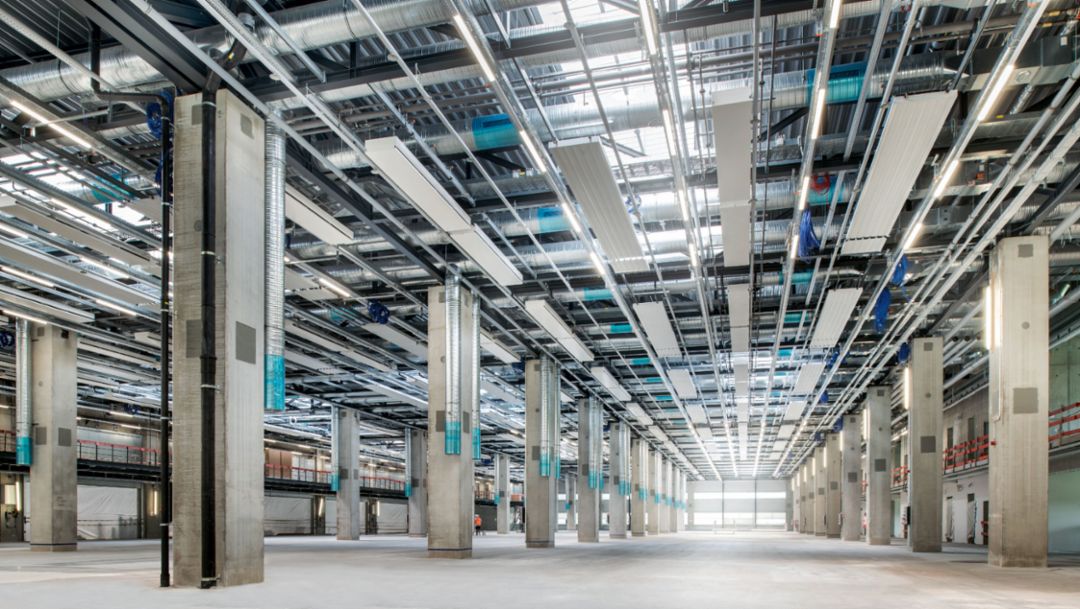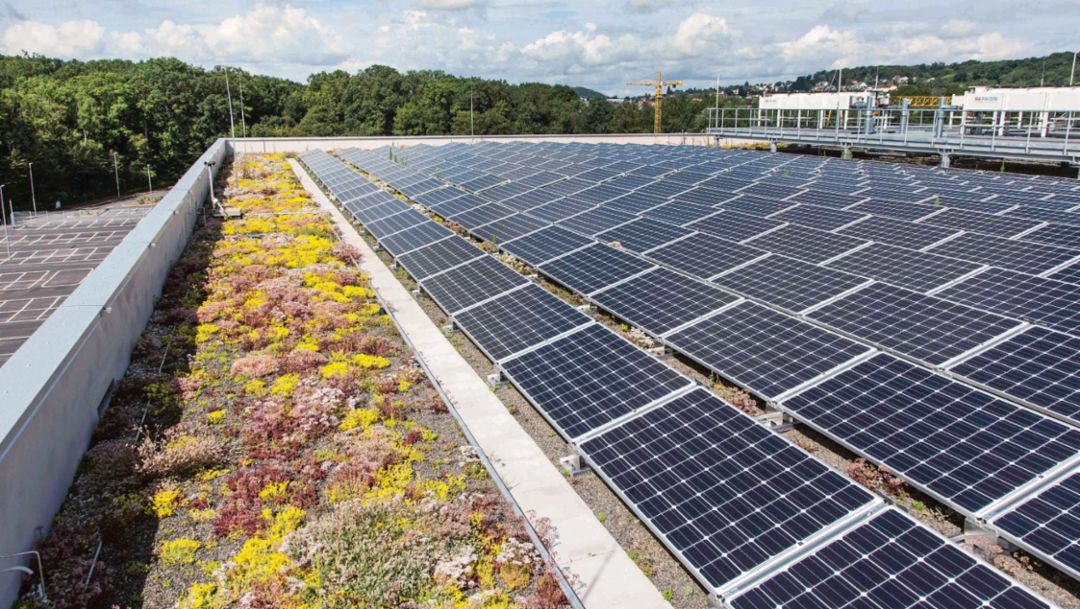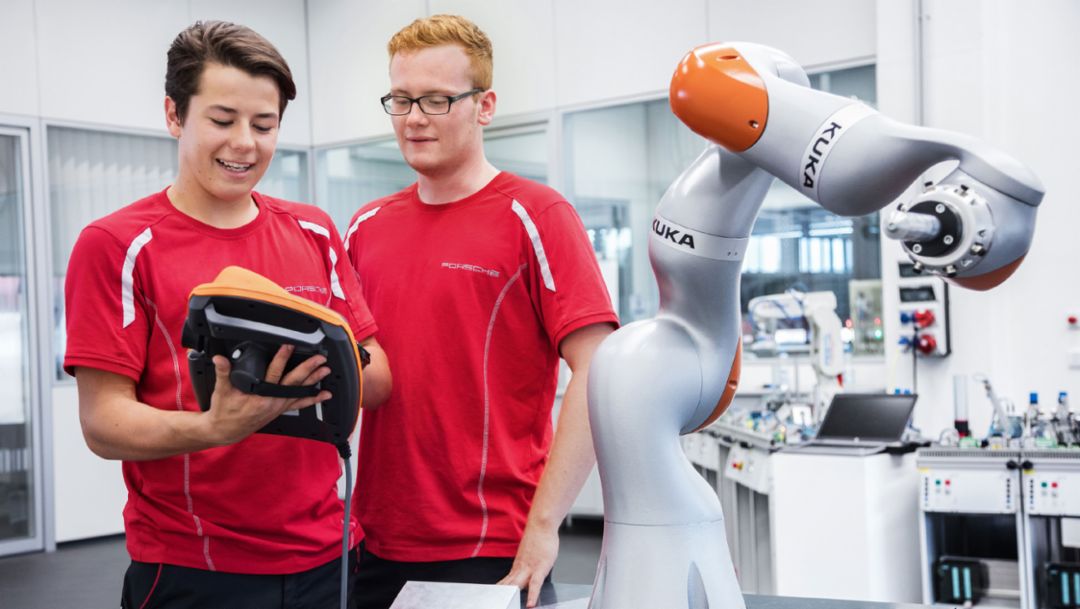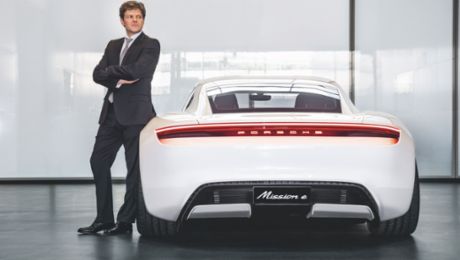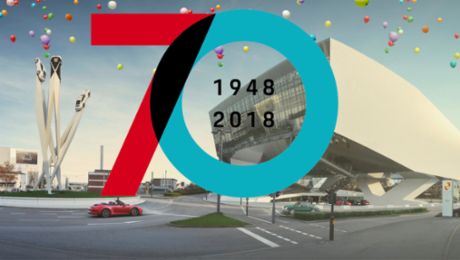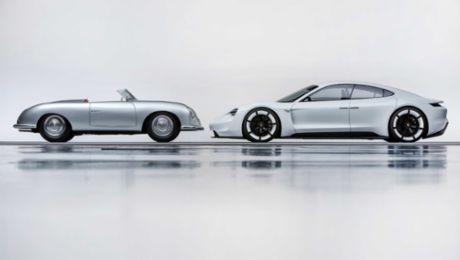The first Porsche, the Type 356 that was produced there in 1950, laid the foundation for the uniquely successful history of the brand. And the first Porsche with a purely electric drive system will also come from Zuffenhausen.
Porsche moved to the Zuffenhausen site 80 years ago, and has grown up with it. The company’s executive decisions are still made in the striking three-storey office building there where everything was launched back in 1938. The assembly halls of the same complex also still exist. Today they house the factory delivery centre and the Exclusive workshop. Plant 1 has been consistently expanded in a related architectural style, up to and including the current square-shaped structure.
Considerable additions have also been made around this historical ensemble. Porsche’s workforce has grown from 176 employees back in 1938 to 30,500 today – around one third of whom are in Zuffenhausen. Its annual production has risen from 1,601 cars in 1953 to 255,683 in 2017 – more than one fifth of which come from Zuffenhausen. The Zuffenhausen premises have grown from the size of a large playing field to an area of around 670,000 square metres, which is equivalent to around 62 football fields. Since 2002, the company’s production capacities have also been increased by the Leipzig plant, which makes the Macan and the Panamera. Zuffenhausen produces all of Porsche’s two-door sports cars – the 911 and 718 series – as well as the petrol engines for the entire product range. Efficient electric motors with sports-oriented performance characteristics will also be made here in the future. The production facilities for the drive system of the Taycan as well as possible derivative models have already been installed.
Porsche makes efficient use of every square metre of its main site in Zuffenhausen. That is quite a challenge at this highly developed industrial area. To make things more complicated, the site is also divided by railroad tracks and a major public road. But ever since the Porsche design office was founded in 1931, the company has belonged in Stuttgart. Stuttgart’s Zuffenhausen district then became its home in 1938. Throughout every part of its history, Porsche has made the best use of its possibilities there. The same is true for the preparations underway to produce the Taycan. The construction project is definitely complex – the new buildings have been erected in and amongst the existing structures while production proceeds as usual, and these new buildings will also be connected by a second conveyor bridge across the well-travelled Schwieberdinger Strasse. The work is being done because this tradition-laden site possesses the capacities to make the first purely electric Porsche. And that sends a clear message: Porsche is Zuffenhausen.
Production at a site rich in tradition
The first Porsche 356s were made in Zuffenhausen in 1950, largely still by hand in a hall rented from the Reutter chassis plant. That was the ideal situation given the comparatively low number of vehicles made in those early days – although production quickly outstripped the plans laid by the young car maker. The 356 became the brand’s first worldwide success. Sales showed continuous growth, so Porsche moved its production facilities to its own new assembly hall designed by the Stuttgart-based architect Rolf Gutbrod by the end of 1952. And that hall was already expanded for the first time in 1954. In late 1955, breathing room became available when the company was able to move back into its own Plant 1 buildings which had been occupied by the Allies since the end of World War Two. The buildings could now house the design department, commercial staff, repair department for company and customer cars, and the race-car test and development department. Production, sales and the supply department for replacement parts remained in Plant 2.
The production department automated an ever-greater number of its processes in order to meet the rising demand for sports cars from Zuffenhausen. And it expanded. It started making engines in Plant 3 on Strohgäustrasse in 1960. On 1 December 1963, Porsche took over the Reutter chassis plant. Plant 2 underwent continuous expansion, including in 1963 when it began producing the Porsche 901 which one year later would become the brand’s next worldwide success known as the 911. In 1969, Building 41, a multiple-storey edifice along Schwieberdinger Strasse, was added to Plant 2. To this day, it accommodates final assembly of all models of the 911, the car of greatest strategic importance to the product range. A sophisticated production principle enables a single line to assemble not only the 911 but also the 718 as well as all race cars based on standard-series sports cars – for the Zuffenhausen plant is also the home of the 911 GT3 R, 911 GT3 Cup and Cayman GT4 Clubsport.
The Zuffenhausen site remains modern
In the 1980s, it became necessary to expand production to the other side of Schwieberdinger Strasse. Plant 5 was built there in 1988 to house highly flexible chassis production facilities. The first conveyor bridge began carrying the finished chassis at a height of around 35 metres across the road to the final assembly station in Plant 2.
Numerous restructuring projects and new buildings have enabled the Zuffenhausen site to meet all the new production demands over the decades. The largest expansion in the company’s history is scheduled to be completed in 2019, when Zuffenhausen will begin producing the Taycan. A new body shop is being built for this purpose in Plant 5, a new paint shop in Plant 1 and a new assembly building in Plant 2 toward Adestrasse. A second conveyor bridge over Schwieberdinger Strasse will connect the production facilities.
Porsche’s new electric sports car will be built on four floors of the new assembly and logistics hall as well as the body shop. Assembly will proceed from the upper floors to the ground floor, where the finished cars will roll from the hall following their final inspection. The technology that controls the entire production process will be housed in the basement. In short, this is a logistical masterpiece that is nearly unique in automotive history.
Sustainability and environmental protection
In expanding and modernising the Zuffenhausen site, Porsche is setting new standards in sustainability. Plant 4 with the new engine plant, the main site workshops and additional office space received platinum certification from the German Sustainable Building Council (DGNB) in 2017. This recognises the economic, ecological, sociocultural and technical quality of the processes used to build new and restructure existing industrial areas. Right next to the site is the Greutterwald nature reserve, an important fresh-air corridor for the centre of Stuttgart. Porsche is actively involved in protecting endangered animal species there.
The Taycan will be the first Porsche whose production processes are completely neutral in terms of CO2 emissions. The company has already been using renewable wind, hydro and solar energy at all its sites since January 2017, and as of 2018 has also been using renewable electrical energy for all rail transport of new cars from the Kornwestheim and Leipzig loading stations. This alone saves more than 6,000 tonnes of carbon dioxide a year. In addition to these efforts, the Zuffenhausen site will use biogas to meet its heating needs as of 2020, which will save an additional 5,000 tonnes of CO2 emissions a year. Resource efficiency is another important area in sustainability work. As one example of this, two projects at the paint shop in Zuffenhausen were recognised by the state of Baden-Württemberg’s “100 Companies for Resource Efficiency” initiative in 2017.
Training at Porsche
Porsche views training as the company’s most important investment in the future. It has been training apprentices since 1942. Nearly 5,000 young women and men have learned a profession and received a permanent employment contract since then. The curricula and training facilities are regularly modified with an eye to future advances in technology and developments in society. As a result, highly qualified and superbly trained young specialists in the fields of electromobility, connectivity, digitalisation and Porsche Production 4.0 are being integrated into the company’s workforce.
In 2018, Porsche accepted 209 trainees and work-study participants at Zuffenhausen. The site currently has a total of around 600. They are in ten technical-industrial and three commercial programmes plus eight departments of the Baden-Württemberg Cooperative State University (DHBW). One new future-oriented programme there is the work-study option in computer science with an automotive IT focus.
These future Porsche employees have been learning and working at a highly modern training centre with 15,000 square metres of space since 2015. The curricula include cutting-edge subjects like virtual reality, augmented reality, sensitive robotics and high-voltage and systems technology. A model learning factory equipped with lightweight robots and digital assembly work stations simulates real processes for Porsche Production 4.0.
Porsche views professional training as one of its responsibilities to society at large. In addition to the approximately 200 trainees accepted every year, the Zuffenhausen site also admits another 20 individuals to a year of special preparatory training. These are young people who have little opportunity for a job on the regular labour market but who can acquire sufficient preparatory skills to then enter a standard traineeship. In addition, 15 refugees go through an “integration year” to prepare for traineeships and jobs outside Porsche.
Identification with the Zuffenhausen district
The Stuttgart district of Zuffenhausen and the Porsche sports car maker have had a close relationship since 1938 when the company found its new home there. Not only the sports cars but also the district itself have made a name for themselves throughout the world. For many fans and friends of the brand, Zuffenhausen is a fixed star in their personal Porsche cosmos.
Zuffenhausen and Porsche enjoy many connections. These include the street known as Porschestrasse and the square called Porscheplatz. The local grammar school acquired the name of Ferdinand Porsche Gymnasium in 1983, and the food at its canteen, which opened in 1994, is supplied by the Porsche company restaurant in Zuffenhausen. Porsche also supports an ongoing series of local projects in areas such as community welfare and nature conservation.
